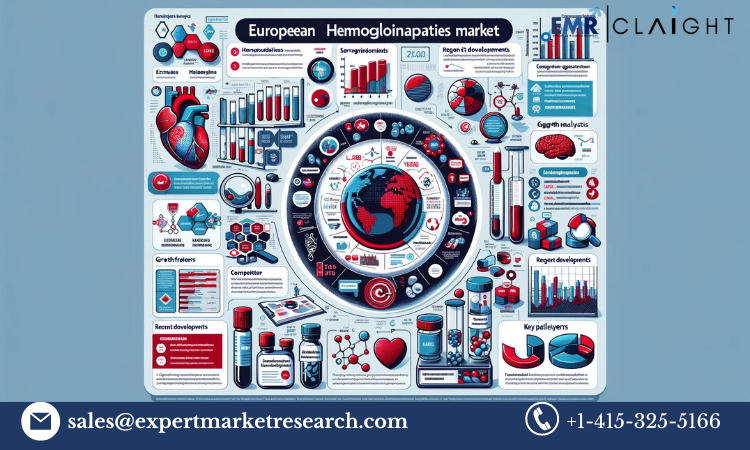Hemoglobinopathies Market Outlook: In-Depth Trends and Forecast (2024-2032)

The hemoglobinopathies market, valued at USD 6.9 billion in 2023, is rapidly expanding due to rising prevalence rates of genetic blood disorders such as thalassemia and sickle cell anemia. These conditions, caused by abnormal hemoglobin production, result in severe complications like chronic anemia, growth delays, and organ damage. Treatment and management are critical, driving the need for innovative therapies and enhanced diagnostic tools.
As the global population grows and the understanding of these genetic conditions deepens, the demand for better therapies, including gene therapy and personalized medicine, is expected to push the market to USD 15.9 billion by 2032, growing at a robust CAGR of 9.7%.
Europe remains the dominant region, with an impressive share due to well-developed healthcare systems, advanced R&D infrastructure, and strong governmental support for rare disease treatment and management.
Hemoglobinopathies Overview
Hemoglobinopathies are a group of genetic disorders that include thalassemia and sickle cell disease, which affect millions globally. These disorders are characterized by the production of abnormal hemoglobin, leading to inefficient oxygen transport in the blood and causing severe health issues.
- Thalassemia: A genetic disorder that causes an abnormal reduction in hemoglobin, leading to anemia and requiring lifelong blood transfusions and iron chelation therapy to prevent iron overload in organs.
- Sickle Cell Anemia: A condition where hemoglobin molecules form into a rigid sickle shape, causing blockages in blood vessels and leading to pain, infection, and potentially life-threatening complications.
Key Statistics:
- Around 300,000 babies are born each year with sickle cell disease globally.
- The prevalence of thalassemia is higher in the Mediterranean, Southeast Asia, and African regions, but global migration patterns have caused the disorder to spread to new regions, including Europe and North America.
Key Market Drivers
- Growing Prevalence of Hemoglobinopathies
- Increasing cases of thalassemia and sickle cell anemia are directly influencing market growth. In many regions, public health screening programs are becoming mandatory, especially in Europe and parts of North America, where genetic disorders are more prevalent due to migration patterns.
- Carrier screening programs and prenatal testing are becoming essential components of healthcare policy in countries with high disease prevalence.
- Advancements in Gene Therapy and CRISPR
- One of the most exciting developments in the hemoglobinopathies market is the rise of gene therapies that offer the possibility of curing these conditions. Gene therapy for hemoglobinopathies works by modifying the patient’s own genetic material to produce healthy hemoglobin.
- CRISPR-Cas9 gene editing technology is a groundbreaking tool showing immense potential for correcting the genetic mutations that cause sickle cell disease and beta-thalassemia. Several companies, including CRISPR Therapeutics, are conducting clinical trials with promising results, potentially transforming the way these diseases are treated in the coming years.
- Increasing Research Funding and Government Support
- Governments and private organizations are ramping up funding for research into rare genetic disorders, particularly in Europe and the U.S., where healthcare systems are robust. For instance, the European Union’s Horizon 2020 initiative has provided significant financial support for research into rare genetic diseases, including hemoglobinopathies.
- In the U.S., the National Institutes of Health (NIH) continues to invest in programs focused on gene therapies and treatments for hemoglobinopathies, including initiatives to support newborn screening programs that help identify these conditions early.
Market Challenges
- High Cost of Treatment
- While treatments like bone marrow transplants and gene therapy provide a chance for long-term relief or even cure, they come with high costs. For instance, gene therapies can cost hundreds of thousands of dollars per patient. The high price tag is a significant barrier, particularly in low-income regions where access to healthcare is limited.
- Long-term treatments, such as regular blood transfusions and iron chelation therapy, also create a substantial financial burden on healthcare systems, particularly in developing nations.
- Limited Access to Advanced Healthcare in Developing Regions
- Despite advancements in technology, access to advanced treatments remains a challenge in regions such as Sub-Saharan Africa and South Asia, where the burden of hemoglobinopathies is high. Healthcare infrastructure limitations prevent many patients from accessing lifesaving therapies.
- Global health organizations and governments need to invest more in affordable diagnostic tools and treatment access in underdeveloped regions, where the burden of disease is often highest.
Emerging Trends in Hemoglobinopathies Market (2024-2032)
- Personalized Medicine: The Next Frontier
- Personalized medicine is revolutionizing the way hemoglobinopathies are treated. By tailoring therapies to an individual’s genetic profile, patients receive more effective treatments with fewer side effects. Companies such as Alnylam Pharmaceuticals are developing therapies that target the genetic root of the disorder, providing more effective and long-lasting solutions.
- Gene Editing and CRISPR Therapies
- As mentioned, CRISPR technology is changing the game for genetic disorders. Ongoing trials are showing that gene editing can correct the underlying genetic mutations causing conditions like sickle cell anemia, providing a potential cure for patients. CRISPR Therapeutics and Vertex Pharmaceuticals have led the charge with their experimental therapies, which could hit the market within the forecast period.
- Growing Telemedicine and Digital Health Adoption
- Digital health platforms and telemedicine are becoming integral to managing chronic conditions like hemoglobinopathies. For patients in remote or underserved areas, these platforms offer a lifeline, allowing them to receive remote consultations, monitor their health, and receive treatments without the need for constant hospital visits.
- Public-Private Partnerships and Collaborations
- The hemoglobinopathies market is seeing a significant rise in collaborations between pharmaceutical companies, academic institutions, and government bodies. For instance, partnerships between Novartis and leading research universities are accelerating the development of next-generation therapies for sickle cell disease. These collaborations will be critical in developing innovative solutions and getting treatments to market faster.
Europe’s Dominance in the Hemoglobinopathies Market
Europe leads the global hemoglobinopathies market, thanks to:
- Strong government initiatives aimed at improving care for genetic disorders.
- High levels of investment in biotechnology research.
- Early adoption of genetic screening programs that allow for early diagnosis and treatment.
Germany, the UK, and France are key markets driving this growth. Government-backed research programs and public-private partnerships in these countries are supporting the development of advanced diagnostic tools and innovative treatments.
Competitive Landscape
The competitive landscape of the hemoglobinopathies market is shaped by leading players driving innovation, including:
- Bio-Rad Laboratories, Inc.: Renowned for its diagnostic products, Bio-Rad is pioneering new ways to detect and monitor genetic blood disorders.
- Bristol-Myers Squibb Company: Active in drug development for rare diseases, the company’s portfolio includes potential treatments for hemoglobinopathies.
- Novartis AG: A leader in gene therapies, Novartis is at the forefront of research into genetic disorders and is investing heavily in curing diseases like sickle cell anemia through innovative therapies.
- Alnylam Pharmaceuticals: This company is focused on RNA-based therapies that offer a unique approach to treating hemoglobinopathies by targeting the genetic basis of these diseases.
Recent Developments and Innovations
- FDA Approval of Gene Therapies
- The approval of Zynteglo, a gene therapy for beta-thalassemia, marks a significant milestone in the treatment of hemoglobinopathies. This therapy offers a one-time treatment option, potentially eliminating the need for chronic blood transfusions.
- Research Collaborations
- Companies like Pfizer have teamed up with Beam Therapeutics to accelerate research on gene therapies targeting sickle cell disease. These partnerships are crucial for driving innovation and bringing new treatments to market faster.
Future Market Outlook (2024-2032)
With gene therapies and personalized medicine poised to revolutionize the market, the global hemoglobinopathies market is expected to grow substantially. Major pharmaceutical companies are investing heavily in R&D, and governments are increasing funding for rare disease treatments. The next decade will likely witness groundbreaking advancements in gene editing and digital health, improving patient outcomes and transforming the standard of care for genetic blood disorders.









